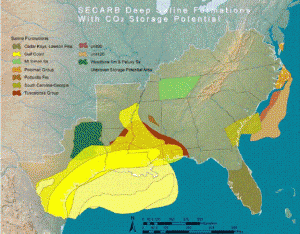On December 2nd, Environmental Defense Fund (EDF) completed a 2-year long research project funded by the U.S. Department of Energy (DOE) to support a University of Texas (UT) project to find suitable sites to sequester carbon dioxide below ground in Texas’ offshore state waters. The research report, which directs site selection, anticipates environmental risks and provides recommendations during project siting and development, was generated to safely and efficiently guide offshore carbon capture and geologic sequestration (CCS) projects to minimize risks to human health and the environment.
Given that a CCS project off the coast of Texas would likely be the first of its kind in U.S. history, the report offers valuable insight to help guide a future demonstration project which may open the door to a potentially huge CCS industry. In 2010, the U.S. DOE evaluated the gulf coast region and found vast potential for storing CO2 in deep saline formations (underground salt-water deposits) as well as in depleted oil and gas fields throughout the area. Similarly, in 2006 the University of Texas evaluated geologic formations across the coastal region, finding exceptional geology for engaging in CCS projects.
EDF’s recommendations, included in Section VII or the report, provide guidelines for use in site selection and development for offshore CCS projects in Texas, including:
- Following threshold standards to avoid negative effects on human health or coastal natural resources;
- Taking an overall precautionary approach wherever possible;
- Performing site-specific evaluations within the full zone of potential impact, even if not required by law;
- Choosing sites with the least potential for leakage;
- Applying recently adopted U.S. EPA rules for groundwater protection even if not required by law;
- Locating sites as far from shorelines and existing aquifers as feasible;
- Reusing or collocating equipment new project footprints;
- Selecting back-up sites where possible;
- Developing site specific monitoring, verification, accounting, and reporting plan; and
- Evaluating feasible mitigation measure prior to site operation.
To complete the research project, EDF energy and oceans experts performed an in-depth look into the current state of the Texas gulf coast environment and extrapolated lessons learned from operations analogous to CCS to analyze the potential for impact and recommend ways to mitigate overall risk. EDF used examples and best management practices developed for offshore oil drilling, onshore enhanced oil recovery, acid gas and wastewater injection, and offshore CCS projects in other countries to make its suite of recommendations.










